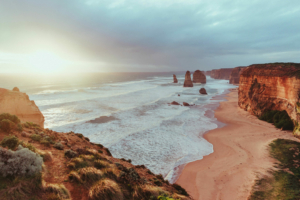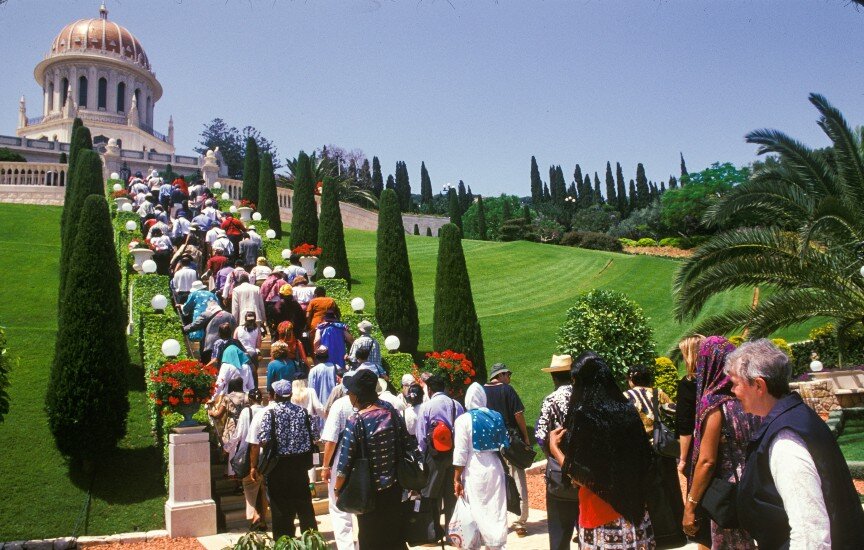Highlighting Australia
- As a proudly Australian initiative, we’re excited to showcase a collection of Australian stories, music, tributes and more.

Join activities, celebrations, study groups, spiritual empowerment and education programs for young people, and more.
Baha’i beliefs address essential spiritual themes for humanity’s collective and individual advancement. Learn more about these and more.


On one glorious evening twenty years ago, people from around the world gathered in person and via television to celebrate the inauguration of a wonder of the world.
They witnessed the spectacularly beautiful ceremony on 22 May, 2001 held to mark the opening of the Terraces of the Shrine of Bab on Mount Carmel in Haifa, Israel.
It was the culmination of a construction project that began just over a decade previously, and of a process that had its origins 110 years earlier.
In 1891 while on the northern slope of Mount Carmel, Baha’u’llah, set in motion the steps to establish a Shrine for His Forerunner, the Bab.
In 1990 the Universal House of Justice announced “to the followers of Baha’u’llah in every land” that on 23 May 1990, one hundred and forty-six years after the Bab declared His mission, work had begun on the project to build the Terraces that would embellish the Shrine.
Described as the “pathway of the kings and rulers of the world”, the Terraces had been envisioned by Abdu’l-Baha, the successor designated by Baha’u’llah as head of the Baha’i Faith, and a widely-loved resident of Haifa.
On that first day of construction 31 years ago this year, Hands of the Cause, members of the Universal House of Justice, Counsellor members of the International Teaching Centre, together with the architect of the Terraces, Mr Fariborz Sahba, visited the Shrines of the Bab and Abdu’l-Baha to pray for divine confirmations to “enable [the] uninterrupted prosecution [of] this majestic enterprise”.
The project proceeded with many challenges but without hindrance until its conclusion in 2000.
The result of this huge construction effort by an international team led by Mr Sahba under the guidance of the Universal House of Justice was a series of 19 exquisite garden terraces that stretched nearly a kilometre up the face of Mount Carmel, adorning the Shrine in the centre.
On the day of the inauguration in 2001, Ben Gurion Avenue leading to the base of the mountain was closed to traffic except for more than 60 buses bringing in more than 2,500 Baha’is from around the world and limousines transporting the dignitaries.
A 16-metre-tall amphitheatre facing the Terraces had plenty of seating to accommodate the Baha’is and the special guests: ambassadors from more than 30 countries as well as Israeli government ministers, parliamentarians, judges, local mayors and religious leaders.
More than 100 members of the national and international media were present. It was some time before the arrival of social media and the use of smartphone cameras.
A statement by the Universal House of Justice was the centrepiece of the occasion. Delivered by the secretary-general of the Baha’i International Community, Dr Albert Lincoln, the statement spoke of the One whose Shrine the Terraces now embellished, and the One for whom He was the Forerunner.
“We humbly trust,” the House of Justice said, “that the wondrous result achieved by the completion of the nineteen terraced gardens, at the heart of which rises the Shrine of the Bab, is a fitting fulfilment of the vision initiated by Baha’u’llah.”
The message concluded with a stirring proclamation: “Let the word go forth, then, from this sacred spot, from this Mountain of the Lord, that the unity and peace of the world are not only possible but inevitable. Their time has come.”
Then it was time for musical presentations. Present were the Israel Northern Symphony, 70 members of the Transylvania State Philharmonic Choir, singer soloists and three Austrian violinists from the Khadem-Missagh family.
A composition by Tolibkhon Shakhidi of Tajikistan commissioned by the Universal House of Justice had as its title “O Queen of Carmel”. With sounds evoking notions of Shiraz, the cantata’s lyrics were based on a poetic eulogy to the Shrine by Shoghi Effendi.
Then came “Terraces of Light”, a majestic oratorio also commissioned by the Universal House of Justice and composed by Lasse Thoresen of Norway.
The lyrics were from Baha’u’llah’s Tablet of Carmel, the foundational scripture for the Shrine that was revealed on the mountain in 1891. The oratorio ensured that once more the mighty words of Baha’u’llah resounded on that holy mountain.
As that music reached its crescendo, and as the sky turned a rosy, post-sunset hue, lights began to illuminate each of the 19 Terraces, one by one, evoking gasps of admiration from the entranced audience.
On that magic night, the Shrine and the Terraces remained illuminated until late, thrilling not only the Baha’is and the guests and those watching from around the world, but also the residents of Haifa, who had been patient during the years of construction and now were rewarded with a vision of unsurpassed loveliness.
The next day, Wednesday, 23 May 2001, some 3000 Baha’is led by the Universal House of Justice ascended the Lower Terraces to the Shrine of the Bab after musical presentations, including from a youth choir from the Democratic Republic of the Congo in their multi-coloured costumes.
Among the many other activities for the Baha’is present, was an evening event attended by the two surviving Hands of the Cause, Mr Ali-Akbar Furutan and Dr Ali-Muhammad Varqa, and the members of the Universal House of Justice. One of the members, Mr Glenford Mitchell, read the institution’s message to the Baha’is gathered for the events. It concluded with a proclamation of hope:
In the transformation that has taken place on Mount Carmel, the Baha’i Cause emerges as a visible and compelling reality on the global stage, as the focal centre of forces that will, in God’s good time, bring about the reconstruction of society, and as a mystic source of spiritual renewal for all who turn to it.
International recognition came in 2008 when the Shrines of the Bab and Baha’u’llah became the first sites associated with a religious tradition born in modern times to be added to the UNESCO World Heritage list. And on the 10th anniversary of the official opening of the Terraces, a ceremony was held to mark the inauguration of the UNESCO Peace and Tolerance square positioned in front of the Terraces. That year,760,000 visitors took tours of the Terraces. The numbers of visitors and Baha’i pilgrims has kept growing.
The 20th anniversary of the inauguration of the Terraces in 2021 comes as construction proceeds on an individual Shrine for Abdu’l-Baha, whose vision of the Terraces is now a living reality.
"*" indicates required fields

We recognise their continuing connection to land, waters and community. We pay our respects to Aboriginal and Torres Strait Islander people and their cultures; and to elders both past and present.
The views expressed in our content reflect individual perspectives and do not represent authoritative views of the Baha’i Faith.

Visit the site of the
Australian Baha’i Community
and the Baha’i Faith Worldwide
Notifications